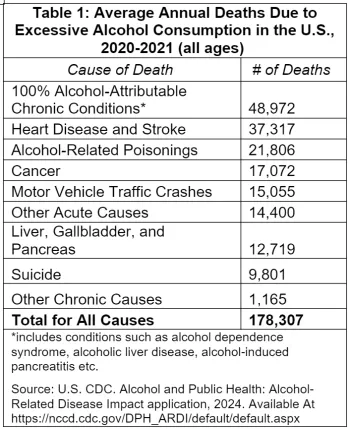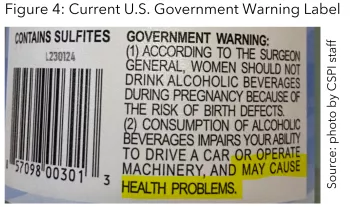Why we need more transparent alcohol labeling
Unlike nearly all other beverages, foods, and supplements, basic information such as calories, ingredients, and nutritional content is not currently required on labels for most alcoholic beverages. Alcohol labels also lack information to help consumers drink in moderation, such as the number of servings and standard drinks per container. A 2024 nationally representative poll of 1,500 U.S. adults who drink alcohol found that the majority want more information on alcohol labels.
Alcoholic beverages should be required to have full ingredients lists, major allergen disclosures, and Serving Facts labels.
Figure 1: Model 'Serving Facts' information

Serving Facts labels should include:
- Serving size (in fl. oz. or mL)
- Number of servings per container
- Number of standard drinks per serving
- Percent alcohol by volume (% ABV)
- Calories per serving
- Nutritional content (Total Fat, Saturated Fat, Sodium, Total Carbs, Total Sugars, Added Sugars, Protein)
- A statement describing the Dietary Guidelines for Americans’ (DGA) advice on moderate drinking
Products that contain 2 to 3 servings per container should be required to list the number of standard drinks and amounts of calories and nutrients both per serving and per container (see Figure 1).
Regulators should also consider including the percent Daily Value for each nutrient.
No product should be exempt from nutrition labeling. However, since many alcoholic beverages do not contain substantial amounts of most nutrients, such products could bear a footnote. For example, instead of including zeroes in the Serving Facts table, the example above could have a footnote stating, “Not a significant source of Total Fat, Saturated Fat, or Protein.”
All of this information should be required on the container and in a format that is easy to read and that stands out against other packaging elements. If the information appears online or via a QR code, it should be in addition to the information on the physical packaging.
Why is alcohol content, calorie, nutrition, and allergen information important?
1. Alcohol content labeling can help people monitor their drinking to prevent alcohol-related accidents, diseases, and deaths.

Excess alcohol consumption (over the DGA’s recommended daily limit of ≤ 2 standard drinks per day for men and ≤ 1 standard drink per day for women) was responsible for 178,307 deaths on average per year between 2020-2021 (see Table 1). Consumers currently have no straightforward way of knowing how much alcohol they are consuming. For example, a person might not realize that a single 24-oz can of Colt 45 malt liquor contains 3.2 standard drinks, which exceeds the recommended limit for both men and women. Alcohol content information like serving size, % ABV, and standard drinks per serving and per container can assist consumers with monitoring their alcohol intake and adhering to the DGA moderate drinking recommendations.
2. Calorie and nutrition labeling can help people avoid excess intake of calories, added sugars, saturated fat, and sodium, which can cause weight gain andchronic disease.
Alcohol is calorie-dense and contributes substantially to the average daily energy intake of those who drink (about 9% of daily calories, on average). Without labels, consumers struggle to accurately estimate or compare the calorie content of alcoholic beverages. Calorie labeling on alcoholic beverages could help consumers stay within their daily calorie limits, thus representing an opportunity for improved weight management among adults who drink.

Alcoholic beverages can also contain high levels of added sugars, saturated fat, and sodium (see Figure 2). For consumers to successfully limit these nutrients, as recommended by the DGA, this information must be accessible on labels.
People with chronic diseases (e.g., diabetes), may need access to additional nutrition information (e.g., carbohydrates) to safely consume alcohol.
3. Major allergens and full ingredients lists provide critical information for those with allergies and transparency for all.
Roughly 11% of U.S. adults live with allergies to over 170 foods. Alcoholic beverages can contain a wide range of ingredients and food additives, including many of these allergens. For example, federal regulations specify more than 70 ingredients that can be added to wine, including albumen (egg white), isinglass (a gelatin from fish), and casein (a milk protein). Alcoholic beverage labels should be required to highlight the same nine major allergens that must be highlighted on other beverage and food labels. Full ingredients lists would additionally protect those allergic to non-major food allergens and provide information for consumers who avoid specific ingredients for other reasons, including sensitivities, health conditions, religion, personal preferences, and commitments to specific dietary patterns (e.g., vegan and vegetarian).
Why isn’t alcohol already labeled like other foods and beverages?
Only a small subset of alcoholic beverages are regulated by the U.S. Food and Drug Administration (FDA), which requires calorie, nutrition, and ingredient labeling for the alcoholic beverages it regulates. Beverages regulated by the FDA include wines and hard ciders with < 7% ABV and beers made from malted barley substitutes (e.g., hard seltzers made from fermented sugar).

By contrast, Alcohol and Tobacco Tax and Trade Bureau (TTB) within the Department of the Treasury regulates the vast majority of alcoholic products and does not require nutrition, ingredients, or allergen labeling for most products. TTB only requires the disclosure of a handful of specified ingredients, if present. And only TTB-regulated products labeled as “light” or making claims about their calorie or carbohydrate content are required to bear nutrition information in the form of a Statement of Average Analysis (i.e., a disclosure stating the calorie, carbohydrate, protein, and fat content per serving). For all other alcoholic beverages and label information, TTB applies voluntarylabeling policies.
Unfortunately, uptake of TTB’s voluntary alcohol labeling is low. CSPI used TTB’s own database to examine the labels of 132 of the top beer and wine brands by sales volume in 2020 and found that the voluntary "Serving Facts” label (which includes a Statement of Average Analysis plus servings per container and alcohol content) appears on only 28% of beers and no wines (see Figure 3). The study found ingredients lists on 17% of beers and no wines.
Alcoholic beverages also need better health warning labels

Strong evidence shows that consuming alcohol increases the risk of liver disease, cardiovascular disease, and certain cancers (including mouth, throat, liver, colon, and breast cancer). However, most people in the United States are unaware of this risk. The current mandated warning states that alcohol “may cause health problems” (see Figure 4), which is non-specific and drastically downplays the well-established links between alcohol consumption and health harms.
TTB should take action to adopt mandatory, transparent alcohol labeling
The Treasury Department is poised to issue rules that would require nutrition, ingredients, and allergen labeling on all alcoholic beverages. In 2022, TTB stated that it was expected to issue these rulemakings by the end of 2023, but it has continually delayed issuance and missed its stated deadlines. TTB should act swiftly to ensure transparent nutrition, ingredients, and allergen labeling for alcoholic beverages. If TTB continues to delay these rulemakings, Congress should consider moving all alcohol labeling authority from TTB to FDA.
To increase awareness of the link between alcohol and cancer, TTB should also report to Congress on the need for a label stating that alcohol consumption may increase the risk of cancer. The Alcoholic Beverage Labeling Act of 1988 directs TTB, in consultation with the Surgeon General, to notify Congress of the need to update health warnings on alcoholic beverages if “available scientific information would justify a change in, addition to, or deletion of the statement.” A report from TTB to Congress would prompt the necessary legislative process for updating the current health warning label. The United States should follow the lead of countries like South Korea and Ireland that have already adopted cancer warning labels on alcohol containers.
Tags
Topics

